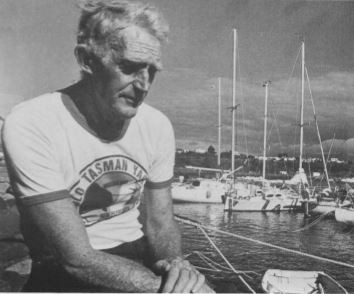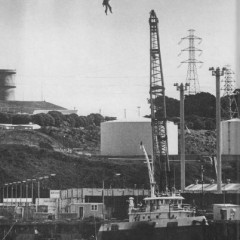13:6
And three years later made world news when he beat the American, Pete Sarron (subsequently world champion) in three historic bouts. The first was in New Plymouth's Western Park before a record crowd of more than 8000. Other outstanding boxers have included Dick Loveridge, Tommy Thompson, George Richardson and, more recently, Pat Ryan. Ryan had a long and successful career at various weights between 1966 and 1977, representing New Zealand at the 1972 Munich Olympic Games as a featherweight. In 1976 New Plymouth was host for the New Zealand amateur boxing championships, and in the same year crowds packed the Opera House for an international competition between New Zealand and Fiji-Tonga, all bouts being won by New Zealand boxers.
Even before the establishment of the settlement, the sea off New Plymouth, inhospitable as it often is, has held attractions for the area's inhabitants. The Maoris reaped much of their food from the abundance of fish which could be caught quite close to land; Dicky Barrett and his rumbustious crews used their four and five-oared boats to capture whales on their migratory tours; then the first European settlers, using the boats which had brought them through the surf, ventured out for pleasure and profit to augment their meagre food supplies. With the building of the breakwater the comparatively sheltered harbour was used for pleasure boating, and by 1939 the New Plymouth Boating (later renamed Yacht) Club was formed. There was criticism arising from fears that the harbour was still too open for small boats. But the club grew in numbers and reputation, and by 1960, with a membership of more than 400, it was one of the largest in the country. When Sir Francis Chichester, the round-the-world solo yachtsman, visited the port in 1968 more than 60 local yachts provided his ship, the Gothic, with a guard of honour. The club has produced some highly qualified yachtsmen, among them Paul Francis, who represented New Zealand in the 1977 world championships in France. He was placed 6th overall. In April, 1970, the first transtasman solo yacht race left New Plymouth for Mooloolaba, near Brisbane.
Six yachts competed and the first across the line was Rebel, a trimaran, owned by Marvin Glenn, of San Francisco, who took nine days to make the crossing. The second race, four years later, attracted nine men and one woman, Annette Wild, of Christchurch. The first to finish was Bill Belcher of Waiheke Island in his 24ft sloop Raha. It was the third race, in 1978, which made world headlines, not only because the fleet of 15 was the largest entered in the race's history, but because of its dramatic sequel. The race began in fair weather, but after a few days of the 1200-mile run it was scattered by a tropical storm, and Belcher, in his cutter Josephine II, specially built for the race, was blown on to Middleton Reef, north of Lord Howe Island, after a week's sailing. The yacht stuck fast. 'After waiting ten days on the reef I got angry and decided that no one was coming to get me,' Belcher said later!", He inflated his life-raft and for the next 28 days drifted, sustained by a diminishing diet of canned fruit, water, tinned sardines-and a raw seagull. He was picked up by a passing ship on May 12, one month and five days after he had set out from New Plymouth.
'Young ladies should keep away from the beach during men's bathing hours. They must know it is highly improper and downright indecent when they sit down within a few yards of the bathing house, knowing well that bathers are waiting for them to retire.' The 'bathing house' referred to in this castigation by the Taranaki Daily News on March 8, 1882, was on the foreshore end of the pool built into the rock foundations of the then sandy beach at Kawaroa. For many years this small concrete-edged pool, which is still used as a paddling area, satisfied the needs of the town's swimmers. But by the turn of the century it was obvious that with the sport gaining popularity, a larger pool was required. In 1904 the New Plymouth municipal saltwater baths was built at a cost of$6260. In addition to a large swimming pool which was filled and emptied at each tide, surrounded by 40 dressing boxes, there were hot saltwater plunge boxes with waiting rooms for ladies and gentlemen, a diving area, lavatory and sanitary conveniences.'19 Mixed swimming was not allowed until 1915 when 'family bathing' was permitted between 2 p.m. and 4 p.m. The buildings were wooden, with corrugated iron walls, which required frequent replacement, and for many years the baths were run at a loss to the borough council. Following a spectacular fire in 1927 'great improvements' were made, but maintenance was still a problem. By the end of the 1950s, as a result of demands by the town's swimming and surf clubs, funds were raised for the replacement. On December 14, 1963, the present Olympic-type swimming and diving complex was opened, providing the city with facilities which have been classed as among the Dominion's most up-to-date. Swimming administrators have included many prominent businessmen, teachers and doctors. One name synonymous with the sport is that of Gayton. F. W. Gayton, an Australian, was a keen swimmer and he and his wife (nee Florence Moody, of New Plymouth) took an early and active interest in the sport. Their children included Bessie (for several years secretary of the Taranaki Swimming Centre), Ralph (president of the New Plymouth club and a baths custodian) and Doug, the present curator. Both Bessie and Doug won gruelling Flannagan Cup races in the harbour-Bessie in 1927 and 1931 and Doug
in 1935. This race, held annually since 1916 over 2~ miles of open water, is a memorial to another dedicated swimming administrator, P. J. Flannagan. Only once has it been cancelled: in 1937 as a result of a poliomyelitis epidemic. Several Taranaki swimmers have won national titles. These include J. W. C. Davies (220 yards breast-stroke, 1938 and 1939), T. Logan (100 yards butterfly and 100 yards medley, 1949) and Barnett Bond (four national titles in 1970). Bond also represented New Zealand in the Commonwealth Games in Edinburgh in 1970. The Tarawhata hot mineral baths in Bonithon A venue were exploited following the search for oil in New Plymouth. In 1909 Bonithon Company drilled a hole near the Devon Intermediate School grounds. They found no oil, but plenty of warm mineral water, which ran to waste until 1914 when 1. Solomon, of New Plymouth, built a 25 metre by 12 metre bathhouse which was used as a public swimming pool, as well as several private baths, all of which were enclosed in the same concrete building. These were popular with the public and in 1939 'H. Reedman, Egyptian herbalist' advertised the Tarawhata mineral baths as 'the most modern in the Southern Hemisphere ... which compare with the famous Kreusnach Tonic Springs in Prussia, credited with Miraculous Cures in cases of Rheumatism, Gout, Sciatica, Goitre and all Nervous Ailments as well as a general Tonic for the System. '20, In the mid-1960s these baths were closed to the public, but they continued to be used for several years by swimmers who were training.
In February, 1978, a brown trout weighing nearly 9 kg was taken by 15-year-old Ross Butler from the Waiwakaiho River, one of the two streams which flow through New Plymouth. This was the heaviest recorded fish taken from this once prolific river, for angling has deteriorated in recentyears, mainly because pollution and the removal of rocks and gravel destroyed breeding grounds .. Twenty-five years ago it was not uncommon for large fish to be seen from bridges over the Waiwakaiho, the Henui Rivers and even the Mangaotuku and the Huatoki streams, and many anglers reported good catches of fish weighing up to 5kg. Trout were first liberated in the town's rivers in February, 1875, by the Taranaki Acclimatisation Society a year after it was formed. In 1884 fish ponds were built on the Mangaotuku Stream. In 1907 other fish ponds were built in the Recreation Grounds, later known as Pukekura Park, and five years later a hatchery was established. This hatchery had a varied career and was finally closed in 1925. A new one was built in the Inglewood area. This became uneconomic and in 1961 it, too, was closed. Fingerlings were obtained with increasing difficulty from Hawke's Bay and the South Island. In 1966 rainbow trout were liberated in Lake Mangamahoe to join their brown cousins.
The Taranaki Acclimatisation Society also liberated many sporting and other birds and animals-blackbirds, quail, goldfinches, sparrows, hawks, ducks, partridges, starlings, skylarks, snipe and woodcock. Animals liberated included opossums, hares and goats and in 1877 three deer were liberated in the Egmont ranges. By 1903 these had become a nuisance, were hand-fed by settlers 'with the result that the animals became importunate and were finally destroyed as they proved dangerous to people.
Billiards has been played in the larger clubs and some homes of the wealthy since well before the turn of the century. In the 1902s public billiards saloons were introduced where the public could play on full-size tables for a fee. As in the rest of the country these developed a somewhat unsavoury reputation as haunts of bookmakers , gamblers and other disreputable characters, and police were frequent visitors. Fifty years ago there was a saloon in the old A & P building on the corner of Devon and Egmont Streets; and another above the Mayfair Theatre. A saloon in Currie Street was the only public billiards and snooker establishment operating in the town in 1980, by which time such saloons had assumed an air of respectability; police feeling that the youth of the town came to less harm in them than they would on the streets. In 1966 the Taranaki Billiards and Snooker Association was formed, since when representatives have competed in the national champion- ships. Brien Bennett, of New Plymouth, won the 1971 national snooker title and was runner-up in the 1973 billiards championship. He has also won the Taranaki billiards title six times since 1968 and the snooker title five times, and is the only Taranaki player to take part in world championships-snooker in Wales in 1973 and billiards in Auckland in 1975. In 1969 he was elected president ofthe New Zealand Billiards and Snooker Association, a position he still held in 1979. Since the television attraction, 'Pot Black,' brought top professional players into the city's living rooms, interest in the game has greatly increased. In addition, most public houses and social centres possess pool tables where, for a slot-fed fee of 20c, players of all ages can develop their skills.

